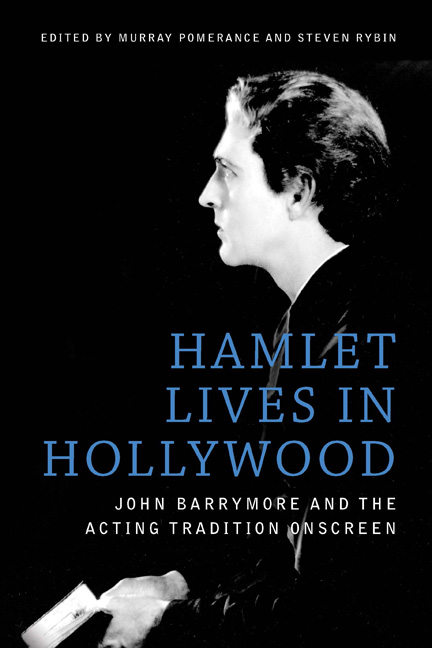Book contents
- Frontmatter
- Contents
- List of Figures
- The Contributors
- Acknowledgments
- Introduction
- 1 The Pre-Bard Stage Career of John Barrymore
- 2 Dangerously Modern: Shakespeare, Voice, and the “New Psychology” in John Barrymore's “Unstable” Characters
- 3 The Curious Case of Sherlock Holmes
- 4 John Barrymore's Introspective Performance in Beau Brummel
- 5 “Keep Back your Pity”: The Wounded Barrymore of The Sea Beast and Moby Dick
- 6 From Rome to Berlin: Barrymore as Romantic Lover
- 7 The Power of Stillness: John Barrymore's Performance in Svengali
- 8 Prospero Unbound: John Barrymore's Theatrical Transformations of Cinema Reality
- 9 A Star is Dead: Barrymore's Anti-Christian Metaperformance
- 10 Handling Time: The Passing of Tradition in A Bill of Divorcement
- 11 John Barrymore's Sparkling Topaze
- 12 “Planes, Motors, Schedules”: Night Flight and the Modernity of John Barrymore
- 13 Barrymore and the Scene of Acting: Gesture, Speech, and the Repression of Cinematic Performance
- 14 “I Never Thought I Should Sink So Low as to Become an Actor”: John Barrymore in Twentieth Century
- 15 Barrymore Does Barrymore: The Performing Self Triumphant in The Great Profile
- Works Cited
- Index
11 - John Barrymore's Sparkling Topaze
Published online by Cambridge University Press: 23 June 2018
- Frontmatter
- Contents
- List of Figures
- The Contributors
- Acknowledgments
- Introduction
- 1 The Pre-Bard Stage Career of John Barrymore
- 2 Dangerously Modern: Shakespeare, Voice, and the “New Psychology” in John Barrymore's “Unstable” Characters
- 3 The Curious Case of Sherlock Holmes
- 4 John Barrymore's Introspective Performance in Beau Brummel
- 5 “Keep Back your Pity”: The Wounded Barrymore of The Sea Beast and Moby Dick
- 6 From Rome to Berlin: Barrymore as Romantic Lover
- 7 The Power of Stillness: John Barrymore's Performance in Svengali
- 8 Prospero Unbound: John Barrymore's Theatrical Transformations of Cinema Reality
- 9 A Star is Dead: Barrymore's Anti-Christian Metaperformance
- 10 Handling Time: The Passing of Tradition in A Bill of Divorcement
- 11 John Barrymore's Sparkling Topaze
- 12 “Planes, Motors, Schedules”: Night Flight and the Modernity of John Barrymore
- 13 Barrymore and the Scene of Acting: Gesture, Speech, and the Repression of Cinematic Performance
- 14 “I Never Thought I Should Sink So Low as to Become an Actor”: John Barrymore in Twentieth Century
- 15 Barrymore Does Barrymore: The Performing Self Triumphant in The Great Profile
- Works Cited
- Index
Summary
In Topaze (1933), principled schoolteacher Auguste A. Topaze, played by John Barrymore, suddenly finds himself in need of a job because, after giving poor marks to a malingering student with politically influential parents, he has lost his teaching position and with it his dreams of attaining an academy medal. An offer shortly comes along from the unscrupulous businessman and politician Baron Philippe de la Tour-La Tour (Reginald Mason)—the father of the disruptive schoolboy whose behavior led to Topaze's dismissal. The Baron promises Topaze that, in exchange for the use of his name in the marketing of a new health beverage, he will receive funding for his scientific researches as well as the academy medal he prizes. The drink, with Topaze's blessing, is to be christened “The Sparkling Topaze.” Innocently assured that it will be his research that guides the formula for the beverage, Topaze agrees to the Baron's plan. He will use his research to create a health drink of benefit to the public and it will bear his name. But the viewer knows something Topaze initially does not: the drink possesses no health benefits whatsoever and is designed only to cheat the public of their money. After he learns of the ruse, Topaze receives a real-world lesson in ethics that challenges his schoolroom ideals.
Topaze is adapted from a French play by Marcel Pagnol who directed his own film version in 1951 (with the popular comedian Fernandel in the title role). The original French play is a satire and a moral tale, critical of unwavering ideals in the face of a contingent social world. In the hands of director Harry d'Abbadie d'Arrast and actor John Barrymore, the 1933 American film version becomes something of a comedy of manners, focusing its attention on Topaze's behavior and reactions as he finds his understanding of human ethics challenged by the administrative bureaucratic class that manipulates him throughout the film.
Central to this film version of the story, of course, is the casting of Barrymore whose star persona and biographical legend inscribe at least two playful ironies into the role. The first is that the dutifully sober Topaze, who becomes dizzy at even the slightest drop of drink and who endorses a beverage with ostensible health benefits, should be played by one of film history's most notorious and passionate drinkers (whose health derived very little benefit from his frequent inebriation).
- Type
- Chapter
- Information
- Hamlet Lives in HollywoodJohn Barrymore and the Acting Tradition Onscreen, pp. 135 - 144Publisher: Edinburgh University PressPrint publication year: 2017

